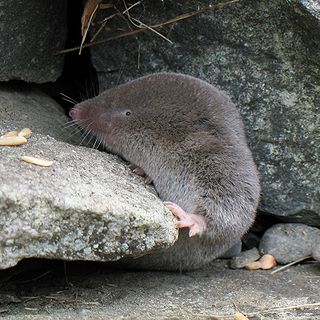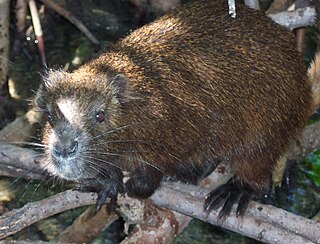
The northern short-tailed shrew is the largest shrew in the genus Blarina, and occurs in the northeastern region of North America. It is a semifossorial, highly active, and voracious insectivore and is present in a variety of habitats like broadleaved and pine forests among shrubs and hedges as well as grassy river banks. It is notable in that it is one of the few venomous mammals. The specific epithet, brevicauda, is a combination of the Latin brevis and cauda, meaning "short tail".

The southern bog lemming is a small North American lemming. Its range overlaps with the other species in genus Synaptomys, the northern bog lemming, in southeastern Canada, but extends farther south.

The Blue Mountains are the longest mountain range in Jamaica. They include the island's highest point, Blue Mountain Peak, at 2256 m (7402 ft). From the summit, accessible via a walking track, both the north and south coasts of the island can be seen. On a clear day, the outline of the island of Cuba, 210 km (130 mi) away, can also be seen. The mountain range spans four parishes: Portland, St. Thomas, St. Mary and St. Andrew.

Hutias are moderately large cavy-like rodents of the subfamily Capromyinae that inhabit the Caribbean islands. Most species are restricted to Cuba, but species are known from all of the Greater Antilles, as well as The Bahamas and (formerly) Little Swan Island off of Honduras.

The Japanese hare is a species of hare endemic to Japan. In Japanese, it is called the Nousagi, meaning "field rabbit".
The dwarf hutia is a small, critically endangered, rat-like mammal known only from Cuba. Aside from tracks, it was last seen in 1937 and may be extinct. It gives birth to only a single offspring at a time, and is threatened by habitat loss and non-native species such as rats and mongoose. The dwarf hutia belongs to the hutia subfamily (Capromyinae), a group of rodents native to the Caribbean that are mostly endangered or extinct.

The Omilteme cottontail is a cottontail rabbit found only in the state of Guerrero, Mexico in the mountain range of Sierra Madre del Sur. Belonging to the family Leporidae, it is one of fourteen species in the genus Sylvilagus, a genus restricted to the New World. The Omilteme cottontail is considered one of the most endangered rabbit species in the world and is only known and been described by very few specimens.

The red ruffed lemur is one of two species in the genus Varecia, the ruffed lemurs; the other is the black-and-white ruffed lemur. Like all lemurs, it is native to Madagascar. It occurs only in the rainforests of Masoala, in the northeast of the island. It is one of the largest primates of Madagascar with a body length of 53 cm, a tail length of 60 cm and a weight of 3.3–3.6 kg. Its soft, thick fur is red and black in color and sports a buff or cream colored spot at the nape, but a few are known to have a white or pink patch on the back of the limbs or digits and a ring on the base of the tail in a similar color.

Geocapromys is a genus of rodent belonging to the hutia subfamily and are currently only found on the Bahamas and Jamaica. However, they formerly ranged throughout the Caribbean, from Cuba to the Cayman Islands to even islands off mainland Central America.

The golden mouse is a species of New World mouse. It is usually 5–8 inches (12–25 cm) in body length, and has a soft pelage that ranges from golden-brownish to burnt orange in color. The genus name comes from the Greek words, ochra, meaning "ocher", a yellow or brown earth pigment; oto-, meaning "ear"; and mys, meaning "mouse".

The Hispaniolan hutia is a small, threatened, rat-like mammal endemic to forests on the Caribbean island of Hispaniola. It lives in burrows or trees, and is active at night when it feeds on roots and fruits. A member of the hutia subfamily (Capromyinae), it is endangered from habitat loss and introduced species, such as rats or feral dogs.

Desmarest's hutia or the Cuban hutia is a stout, furry, rat-like mammal found only on Cuba and nearby islands. Growing to about 60 cm (2 ft), it normally lives in pairs and feeds on leaves, fruit, bark and sometimes small animals. It is the largest living hutia, a group of rodents native to the Caribbean that are mostly endangered or extinct. Desmarest's hutia remains widespread throughout its range, though one subspecies native to the nearby Cayman Islands went extinct shortly after European colonization in the 1500s.

The Cuban boa, also known as the Cuban tree boa and by locals as majá de Santa María, is a very large species of snake in the family Boidae. With lengths exceeding 5 m (16 ft) and a relatively heavy build, the Cuban boa is one of the largest snakes in the world. The species is native to Cuba and some nearby islands. No subspecies are currently recognized.

The Bahamian hutia or Ingraham's hutia is a small, furry, rat-like mammal found only in the Bahamas. About the size of a rabbit, it lives in burrows in forests or shrubland, emerging at night to feed on leaves, fruit, and other plant matter. It was believed extinct until rediscovery in 1964, and it remains the focus of conservation efforts. The Bahamian hutia is a member of the hutia subfamily (Capromyinae), a group of rodents native to the Caribbean, many of which are endangered or extinct.

Smith's red rockhare, Smith's red rock hare or Smith's red rock rabbit is a species of mammal in the family Leporidae, and is the smallest member of the genus Pronolagus. The upperparts and gular collar are reddish brown in colour. It has warm, brown, grizzled, thicker hairs at the back of the body, and white to tawny, thinner underfur. It is native to Africa, found in parts of Kenya, Lesotho, Malawi, Namibia, South Africa, Tanzania, Zambia and Zimbabwe. It is a folivore, and usually forages on grasses, shrubs and herbs. It breeds from September to February, and the female litters one or two offspring. The young leave the nest at three years of age. In 1996, it was rated as a species of least concern on the IUCN Red List of Endangered Species.















